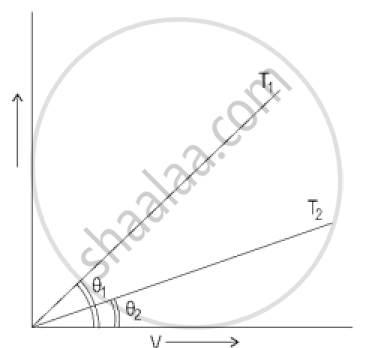Advertisements
Advertisements
Question
Can a hot-wire ammeter be used to measure a direct current of constant value? Do we have to change the graduations?
Solution
A hot-wire ammeter measures the rms value of current for an alternating current. So, it can be used to measure the direct current of constant value because that constant value will be equal to the rms value of current. As, the rms value of the current is same as the direct current thus we need not change the graduations.
APPEARS IN
RELATED QUESTIONS
The given graph shows the variation of photo-electric current (I) versus applied voltage (V) for two difference photosensitive materials and for two different intensities of the incident radiations. Identify the pairs of curves that correspond to different materials but same intensity of incident radiation.

Two alternating currents are given by `i_1 = i_0 sin wt and i_2 = i_0 sin (wt + pi/3)` Will the rms values of the currents be equal or different?
Can the peak voltage across the inductor be greater than the peak voltage of the source in an LCR circuit?
An alternating current is given by i = i1 cos ωt + i2 sin ωt. The rms current is given by
Find the time required for a 50 Hz alternating current to change its value from zero to the rms value.
The household supply of electricity is at 220 V (rms value) and 50 Hz. Find the peak voltage and the least possible time in which the voltage can change from the rms value to zero.
An electric bulb is designed to operate at 12 volts DC. If this bulb is connected to an AC source and gives normal brightness, what would be the peak voltage of the source?
A capacitor of capacitance 10 μF is connected to an oscillator with output voltage ε = (10 V) sin ωt. Find the peak currents in the circuit for ω = 10 s−1, 100 s−1, 500 s−1 and 1000 s−1.
A coil of inductance 5.0 mH and negligible resistance is connected to the oscillator of the previous problem. Find the peak currents in the circuit for ω = 100 s−1, 500 s−1, 1000 s−1.
In a series RC circuit with an AC source, R = 300 Ω, C = 25 μF, ε0 = 50 V and ν = 50/π Hz. Find the peak current and the average power dissipated in the circuit.
Answer the following question.
A small town with a demand of 1200 kW of electric power at 220 V is situated 20 km away from an electric plant generating power at 440 V. The resistance of the two wirelines carrying power is 0.5 Ω per km. The town gets the power from the line through a 4000-220 V step-down transformer at a sub-station in the town. Estimate the line power loss in the form of heat.
Do the same with the replacement of the earlier transformer by a 40,000-220 V step-down transformer (Neglect, as before, leakage losses though this may not be a good assumption any longer because of the very high voltage transmission involved). Hence, explain why high voltage transmission is preferred?
If `|vec"A" xx vec"B"| = sqrt3 vec"A" . vec"B"` then the value of is `|vec"A" xx vec"B"|` is
Phase diffn between voltage and current in a capacitor in A.C Circuit is.
In a transformer Np = 500, Ns = 5000. Input voltage is 20 volt and frequency is 50 HZ. Then in the output, we have,
When a voltage measuring device is connected to AC mains, the meter shows the steady input voltage of 220V. This means ______.
In the Figure below, the current-voltage graphs for a conductor are given at two different temperatures, T1 and T2.

- At which temperature T1 or T2 is the resistance higher?
- Which temperature (T1 or T2) is higher?
